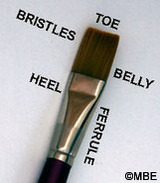Some Basic Brush Care Tips
I had a request as a comment on a previous article to talk about some basic brush care tips. I’m no expert on the topic but I’ve ruined more than enough brushes to know there are a few traps to avoid in order to keep your brushes in working condition as long as you can.
Keep the Ferrule Clean

The ferrule of the brush is where the bristles are glued together and held to the handle. If paint is allowed to work its way up into this area of the brush and dry, it will start pushing bristles outward and causing the tip to start losing its shape. It’s best not to dunk a brush completely in your paint when loading it up for this reason. Overloading a brush makes it harder to control the paint to begin with, but by keeping the paint limited to the tip of the brush you’ll also help keep the ferrule clean.
Clean & Condition your Brushes
Once every so often you should clean and use use brush soap (I use this) to help keep your brushes in shape. I use the soap to clean the bristles, then reshape the brushes, coat them in the conditioning soap, and let them sit overnight to condition. This process will help remove any paint from between bristles and even the occasional bit that escapes up into the ferrule as well as replace some of the oils in natural bristle brushes.
Keep the Bristles Shaped
Detail work requires a steady hand and a sharp brush. While the former can only be developed by practice, the later can be quickly lost if you don’t take care of your brush. In addition to the tips above, make sure you don’t abuse your brush when painting with it. Specifically, stippling or stabbing at a miniature with a brush is going to be a good way to ruin the tip. Drybrushing is really hard on brushes as well. That’s why most painters keep old brushes around to do their drybrushing with. I’ll occasionally run a brush perpendicular to a surface to do something like highlighting the edge of an armored plate, but for the most part make sure you’re painting by dragging the bristles along the surface without torquing them in an odd direction.
Don’t Drown Your Brush
When you store your brushes, store them either with horizontally or vertically with the bristles in the air. Never store brushes tip down. Likewise, don’t leave a brush to soak in water or cleaner bristles down either – this will mash the tip and if you leave it in long enough, start to dissolve the glue in the ferrule.
Brush Caps aren’t Trash
Most decent quality brushes you’ll buy will come with plastic sleeves that slip over the bristles. Don’t throw these away – they do a great job protecting a brush during storage or transport. If a brush is covered with one of these caps, the bristles won’t bend or become misshapen as it bounces around in a drawer, bag, or wherever you’re keeping your supplies. Even if you use a pretty safe storage device where accidents aren’t likely, it’s better to be safe than sorry.
Those are a few of the things I’ve picked up the past few years. If anyone has any other tips for painters regarding brush care and/or use, please share!
Great tips (pun intended).
…
groan.